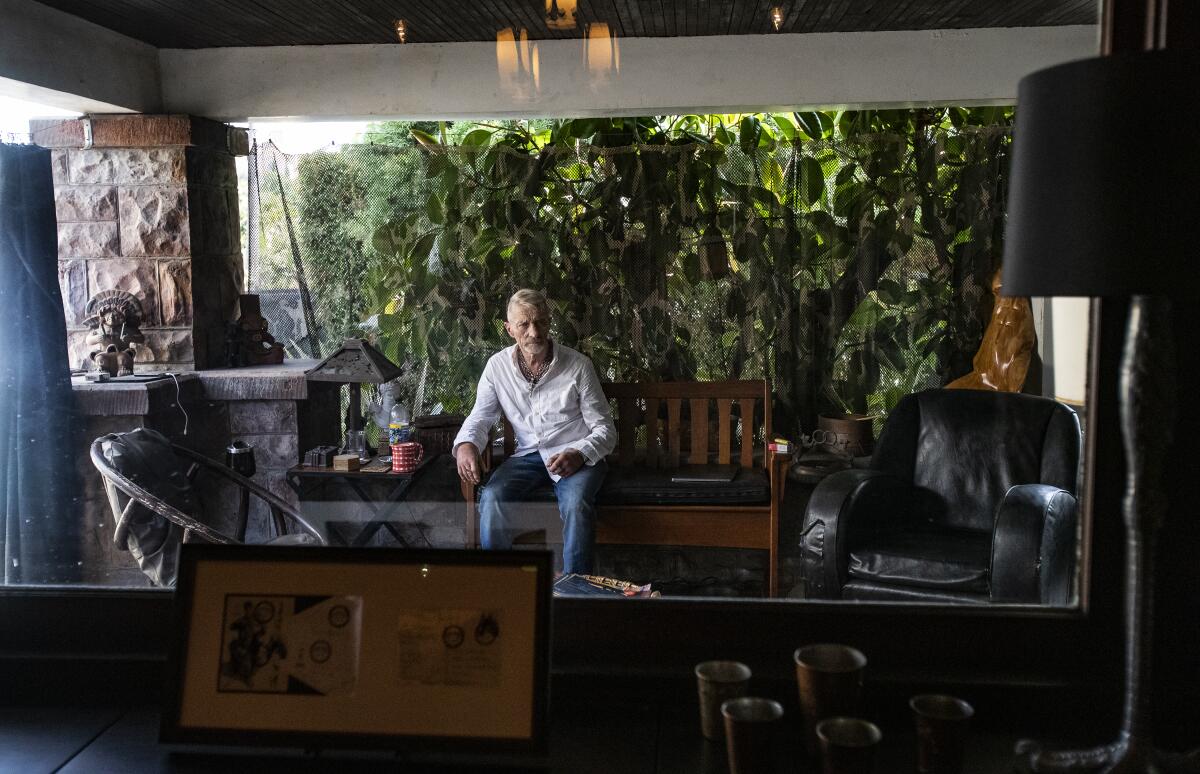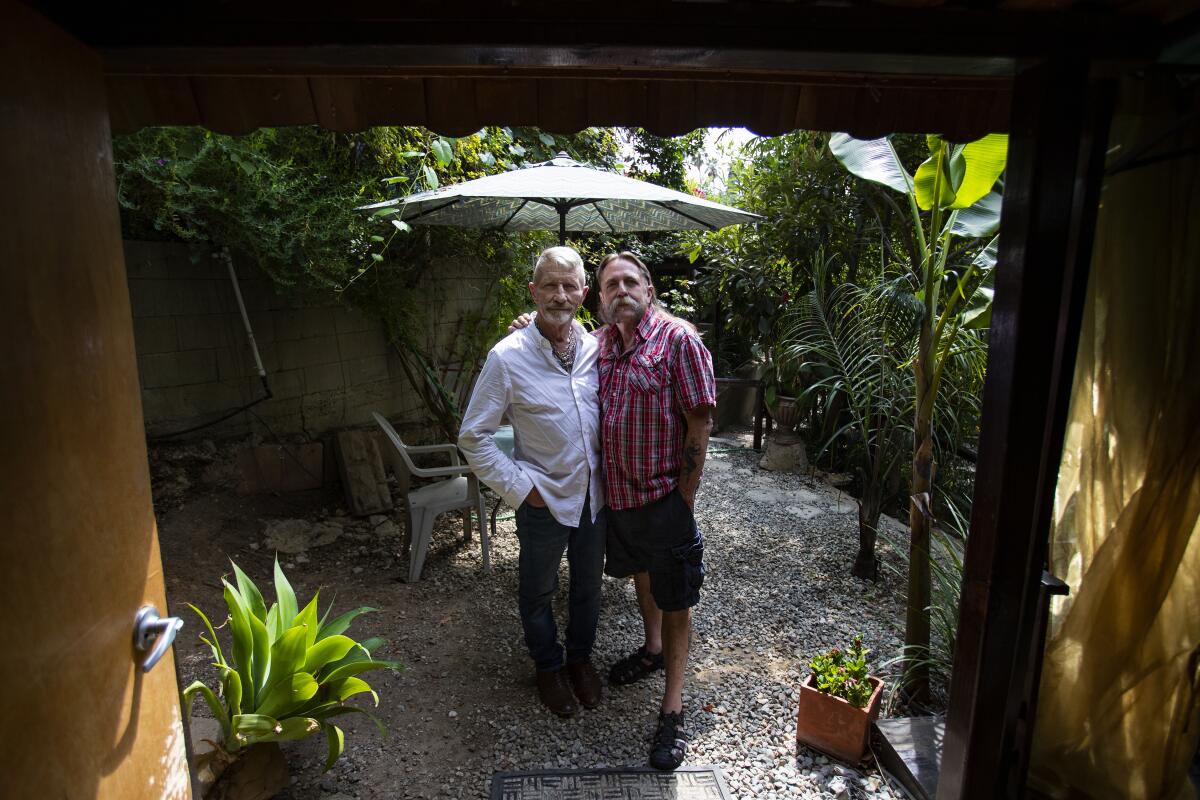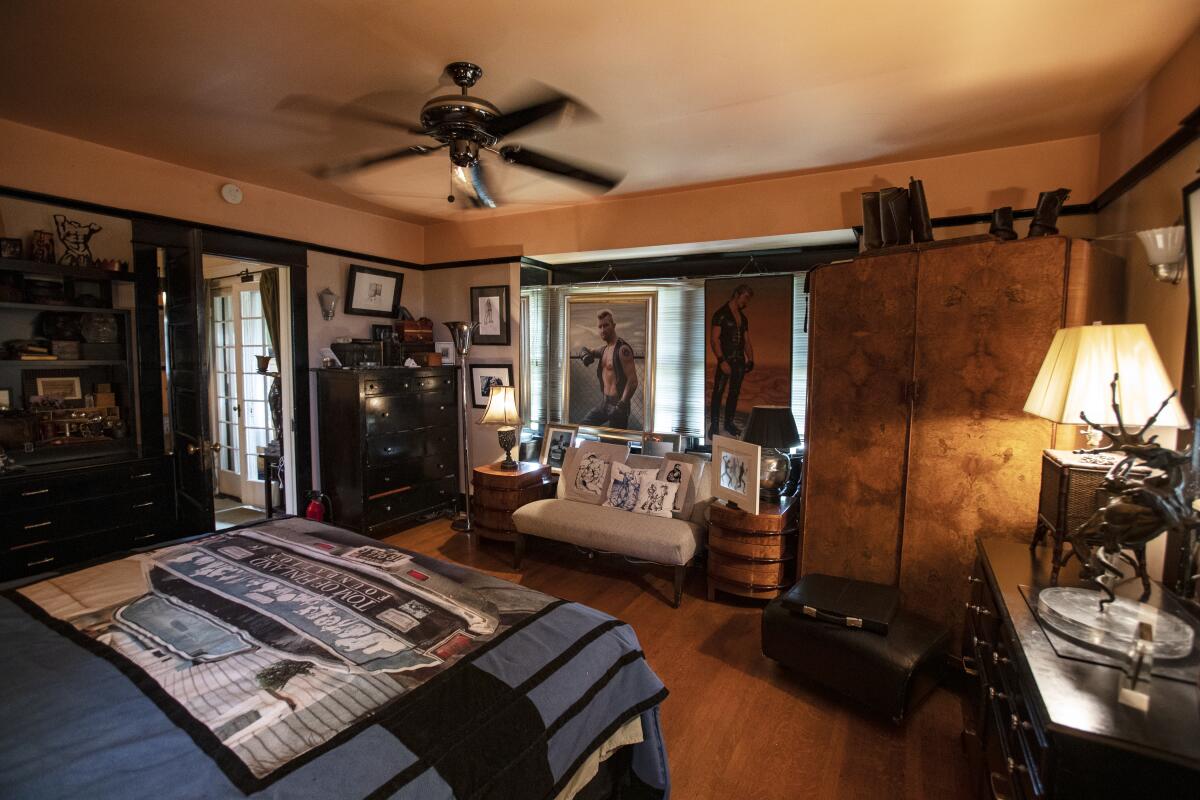An L.A. home where homoerotic artist Tom of Finland lived is a shrine to his legacy

- Share via
Fashion designer Timoteo Ocampo flips through drawings in an attic room high above Sunset Boulevard where homoerotic artist Tom of Finland lived and worked in his final decade.
“I love this look, very biker ‘Sons of Anarchy,’” Ocampo says, pointing to a 1980s drawing of muscle studs astride motorcycles, their low-rise jeans snug over pneumatic rears that threaten to torch the page. A few flips later, he taps another Tom of Finland work, landing inspiration for his fetish-inspired apparel line.
“Booty shorts. Very important this next season. The boys want them shorter and shorter.”
Ocampo’s search (he’ll include branded “Tom” tags on jeans) takes place in a 1911 Echo Park Craftsman that’s command central for all things Tom of Finland. Made a Historic-Cultural Monument by the city in 2016, the property was both home and family for the artist — born Touko Laaksonen (1920-91) — during his final re-imagined 60s.
Owned by Laaksonen’s lover, business partner and muse, Durk Dehner, the now private-public residence houses the Tom of Finland Foundation, holder of the largest collection of Tom art, about 1,500 works. All told, the organization stewards more than 100,000 images and related materials including vintage pornography — billed as the world’s largest repository of erotic art.
“I made a pact with Tom before he passed that I would do everything within my capacity to keep him out in the popular culture,” says Dehner, 70, who in 1980 invited the artist to live in his just-purchased Echo Park home (he stayed for six-month stretches allowed by his visa). Their bond began with a fan letter Dehner sent in 1976 upon spotting a drawing in a leather bar.
Tom’s cocksure leather look — a breakout sultry aesthetic dating to the 1950s — captured the early attention of artists such as Robert Mapplethorpe, Raymond Pettibon and Mike Kelley. It also influenced fashion and music: designers Jean-Paul Gaultier and Thierry Mugler and Queen’s Freddie Mercury. Today, Finland embraces its artist-son as a national hero, one backed by plenty of online merch — as diverse as sex toys and holiday ornaments. Tom’s bevy of built rogues, always affable and forever awash in unapologetic lust, has indeed aged well.

“People still want to be that guy,” Ocampo says.
As the holder of Laaksonen’s legacy and 40-year proprietor of “Tom House,” Dehner is still “that guy.” In 1976, his homespun yet tough leatherman look won bar trophies and Tom of Finland’s attention. He had just appeared, with his easy grin, blond locks and thick mustache, in fashion photographer Bruce Weber’s book “Looking Good.” His bodywork clients included Rock Hudson, Tuesday Weld, Grace Jones and Liza Minnelli.
In L.A., Dehner coordinated Tom of Finland exhibits and helped the artist gain solid footing by battling rampant piracy of his work: They launched the foundation in 1984. Moreover, Dehner welcomed Tom of Finland into his polyamorous leather brotherhood of seven men; some also lived in the house.
“It was exhilarating for Tom because it was like living the life that he had done in his drawings,” says Dehner, seated on his front porch near S.R. Sharp, his partner of 20-plus years, also a resident and the foundation’s vice president. “And he got to experience just being part of the family.”
The two men swap tales of Tom of Finland’s final blast of a decade in L.A., the late July breeze flavored by Sharp’s Marlboros. Fronted by a fortress hedge, their cross-gabled house is perched at the crest of Laveta Terrace lined with Mexican fan palms soaring nearly 100 feet — a swaying beacon amid Echo Park hills.

“Tom loved cops,” says Dehner, referencing the artist’s uniform fetish (he also drew heroically endowed loggers, sailors and soldiers — the latter sparked by his sexual encounters as a World War II lieutenant). The Dehner tribe would lunch at the nearby Los Angeles Police Academy, so close it’s walkable. (Raised in Alberta, Canada, Dehner legally changed his first and last names, the latter after the “Dehner” boot brand he favored; others in his clan followed suit.)
“We’d socialize together,” says Dehner, his neck chains partly veiling “Hellraiser” inked across his chest. “We would actually ... ”
“ ... make casseroles,” interjects Sharp, 64, taking a drag on his Marlboro, revealing “Pure animal” inked on the back of his hand. A snake, dagger, panther and skulls cover his arms and neck amid more cryptic marks.
Downing shots at ‘Tom’s Bar’
Those conventional dinners still occur at Tom House even though Dehner’s original clan has dissipated. Post-meal, visiting leathermen can down shots at “Tom’s Bar” amid the backyard’s leafy paths, terraces and sitting areas staked with a “Pleasure Park” sign, named for a setting in a serial comic the artist created. The more adventurous might be invited down into the home’s dungeon, its black storm cellar doors pitched against the house near the back door. Laaksonen included scenes of kink and bondage, dominance, sadism and masochism in his work. The artist’s leather fetish, like Dehner’s, surfaced during boyhood; he often wore his new leather boots to bed.
Front porch ashtrays brim with stubbed cigarettes and cigars. Camouflage netting shields the open-air stoop from a yard parked with decommissioned Harley-Davidson motorcycles. The home is indeed part frat house. But an initial front porch glimpse can be deceiving.
Certainly, there are the home’s 14 rooms with beam ceilings and stately wainscoting of dark oak trimmed with stained glass: an urbane gentleman’s club. Original Art Nouveau fixtures add flourish. A trio of phallus sculptures, one glass, greets visitors in the foyer. Walls of Venetian plaster are hung with scores of work by top erotic artists (the dining room is primarily reserved for Tom art). The drawing room includes a John Waters original, a commentary on gay “bear” culture that the filmmaker donated (Waters was assigned a leatherman manservant during his first Tom House soirée; he sends annual Christmas cards, some displayed in a breakfast room cabinet).

The property is open to the public for tea salons, nude life drawing sessions and “Films4Fags” screenings. The name’s a nod to the home’s nonconformist cred — “the last fortress of bohemia in a gay cultural landscape that wants desperately to be boring and well-adjusted,” as Tom of Finland collector Volker Morlock has termed it.
In truth, Tom House is a rare queer space — not just reserved for leatherati decked in bulldog harnesses and jackboots.
“There were guys with a little bit of eye makeup on or glitter — twinks were there along with daddies — I mean, such a variety of people,” says M.J. Brown, a.k.a. Miss Barbie-Q, who identifies as “trans femme non-binary gender non-conformist,” of a recent Tom House gathering. “I was on my way to a gig so I was in drag, and everyone was just like, ‘How fabulous,’ ‘Oh cool.’ And no one’s giving me side-eye.”
Trans folk gravitate to Tom art and the property (several have been artists-in-residence) because it provides “a kind of role modeling that they can grab on to and utilize for their own development — which is exactly what Tom did,” says Dehner, his blond hair and goatee a trim contrast to Sharp’s long hair and liberal beard.
“It’s not that the younger ones are not interested” in storied queer history, Dehner adds. “They are. They just need to be invited.” The property has also been a safe haven for erotic artists — one stayed for four years. A bed wedged into the eaves of the foundation’s attic offices is used as needed. The house has weathered its share of grief; about 50 AIDS memorials have been held there.
“I’m the director of the departure lounge,” says Dehner not without a note of weariness. “I’ve assisted many people in passing.”
Younger visitors are eager to learn Tom history, especially during the 1950s when “anything to do with being a man was denied homosexuals,” says Dehner, putting Tom of Finland’s work in historical context. “He wanted to counteract the guilt and shame.” The artist’s virile exemplars helped liberate gay men from society’s cheap assignations — as mentally disturbed fops mincing out roles as faux women.
“Anybody can be a Tom of Finland man — women, anyone,” Dehner says. “Because that’s what it’s about — a state of mind.”
All homes harbor secrets
Tom of Finland’s attic atelier is largely as he left it, his window-facing height-adjustable desk set with a clunky swivel chair. Brushes, drawing sticks and other implements are also in situ. In the 1980s, the steep eaves, now painted white, were wood. One can easily imagine exiting the snug garret, its annex fronted by fleurs-de-lis done in stained glass, and, far below, stepping into a bistro on Rue d’Argout.
The artist created about 800 works in the room, roughly 20% of his documented body of work. The desk is set with a framed copy of a soldier, his final drawing at the house. His days began with morning coffee on the property’s back terraces followed by long hours sketching, a line of cigarette smoke streaming over his paper.
An original 1957 “Physique Pictorial” is propped on a shelf, its cover: Laaksonen’s premiere drawing of shirtless lumberjacks happily plying river logs. Bob Mizer (1922-92) published the popular L.A.-based beefcake magazine that launched Laaksonen’s career, enabling him to eventually quit his Helsinki job as a McCann Erickson illustrator. Mizer appended Laaksonen’s anglicized “Tom” with “of Finland,” the era’s standard nom de plume for male physique photographers.
Down from the attic’s pitched stairs, the foundation’s vast erotica collection unspools, occupying most walls and some ceilings; there’s also a library. Standouts include Benoît Prévot, Arthur Tress, Hector Silva, Don Bachardy, Etienne (Dom Orejudos), Jim Wigler, The Hun (Bill Schmeling), Mark I. Chester and George Quaintance.
Artwork from the Tom of Finland archives (kept somewhat classified) rotates in and out of the house for display. The dining room features preliminary and finished art in a “Some Like it Rough” exhibit — and in Tom of Finland’s world, more than some do.
A Tom of Finland color pencil masterwork hangs in the home’s handsome oak staircase, just down from Mapplethorpe’s portrait of the artist. As with arguably all of the artist’s works, the naked man is unreasonably handsome; glossy jackboots of uniformed men surround him. Laaksonen’s exacting works are “so luminous that they seem to be drawn on pearls,” writes designer Todd Oldham in “Tom of Finland XXL.”
The artist’s work is in the permanent collections of New York’s Museum of Modern Art and L.A.’s Museum of Contemporary Art, among others.
Though the property is somewhat of a house museum (even Dehner and Sharp’s bedroom was open for a tour), that doesn’t include the dungeon, which curator Marc Ransdell Bellenger confirms is operational. All homes harbor secrets that upstairs dinner guests, swirling glasses of Dalla Valle Napa Cabernet, aren’t necessarily privy to.
On a cool July morning, one of the dungeon’s black storm cellar doors was propped open for the first time during several days of visits. Concrete steps bathed in red light led down into a black void. Dehner emerged dressed in full uniformed leather: high boots with white lace-ups, a tie and shirt braced by white suspenders. In that smart kink outfit, he looked angelic.
During a walk to the gate, he chatted about how curious his existence in the house has felt to him, and generally, where he had found himself in life. He seemed slightly astonished by it all.
He unlatched the gate, turned and said, “Come back,” and then, “Come back — any time,” his weathered face bright. Time and again, he had uttered those same words to the curious who had stopped by, astonished to find themselves invited to dinner, and later, maybe a cigar and a round of shots out back.
HOW TO VISIT
Tom House tours are by appointment. Phone (213) 250-1685. 1421 Laveta Terrace, Los Angeles, Calif.
The 24th annual Tom of Finland Art and Culture Festival will be held Oct. 5-6 at Tom House. Events include art showings, an auction, film screenings, life drawing sessions and awards. Cost: $12 per day, $12 for the film screening or $20 for a weekend pass. Food and drink are available for purchase.
Information about weekly tea salons as well as monthly screenings and nude life drawing-painting sessions is available on the Tom of Finland Foundation website. tomoffinlandfoundation.org
More to Read
Sign up for The Wild
We’ll help you find the best places to hike, bike and run, as well as the perfect silent spots for meditation and yoga.
You may occasionally receive promotional content from the Los Angeles Times.










